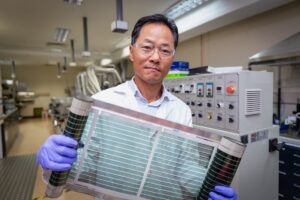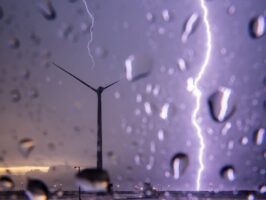In Australia, where the relationship between rural farming communities and large-scale solar has not always been harmonious, a theory that solar panels might act as “massive heat banks” and even spoil food crops has been rolled out in opposition to new development.
But a new international scientific study using satellite technologies has discovered that large-scale solar parks have a cooling effect on the land surrounding them, reducing nearby surface temperatures by up to 2.3°C.
The team of scientists, from Lancaster University, Ludong University in China, and the University of California Davis in the US studied two large-scale projects in arid locations: the 300MW Stateline solar farm in California, and the 850MW Longyangxia solar park in China.
Using land surface temperature data collected through Landsat satellite images, an approach not previously applied to solar farms, the team found that the panels produced “cool islands” extending around 700 metres from the projects’ boundaries.
The temperature of surrounding land surface was reduced by up to 2.3℃ at 100 metres away from the solar park, with the cooling effects reducing exponentially to 700 metres, according to the findings outlined in a paper published by the journal Renewable and Sustainable Energy Transition.
And while further studies would be needed to determine the exact mechanisms that caused the cool island effect and how it might vary with location and design, the team hypothesises that it is due to the solar panels shading and insulating the land surface, as well as energy being converted into electricity by the solar panels.
This contrasts with the findings of the 2016 study that later caught the attention of frustrated Australian fruit farmers and then the regional press. That study, published in the journal Nature, reported that solar farms acted as heat banks, raising surrounding ambient temperatures by 3-4C°.
Of course it is important to note that the two studies used different scientific methods and, most notably, measured the temperature changes differently – land surface vs ambient.
Either way, we can agree that no fruit will be boiled by your average large-scale solar PV farm; but as the team from Lancaster note, the result from this study and others like it will be important to our broader understanding of the ecological impacts solar farms can have – both good and bad.
So while a “cool island” effect might be good for (some) fruit crops, “the scale of effect will depend on the location and could be positive, negative or inconsequential,” as a statement from Lancaster University puts it.
“Most studies examine the impacts of land use change for solar parks inside the site boundaries,” said Dr Alona Armstrong, co-lead author from Lancaster University.
“Here, we found a temperature effect that is evident up to around 700 metres away, suggesting that ecological processes may also be impacted.
“This heightens the importance of understanding the implications of renewable energy technologies on the hosting landscape – we need to ensure that the energy transition does not cause undue damage to ecological systems and ideally has net positive consequences on the places where we build them.”
The researchers also note that as the study was focused on two solar parks in arid locations, further studies will be required to determine if cool islands are caused by solar parks in more temperate locations.
he paper’s authors are: Li Guoqing of Ludong University; Rebecca R. Hernandez of the University California Davis; Alan Blackburn, Gemma Davies, Merryn Hunt, Duncan Whyatt, and Alona Armstrong of Lancaster University.










